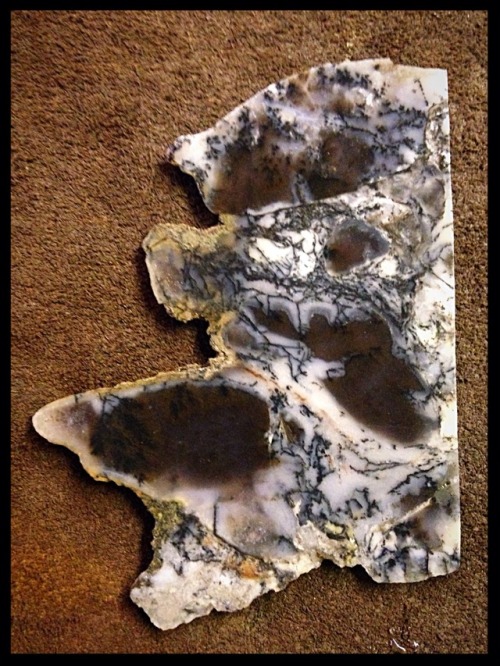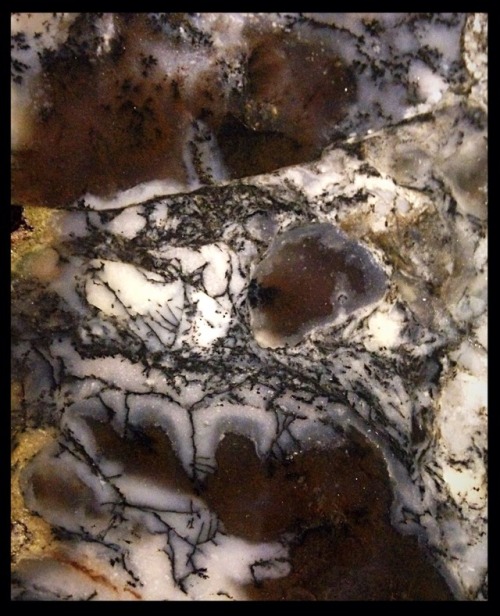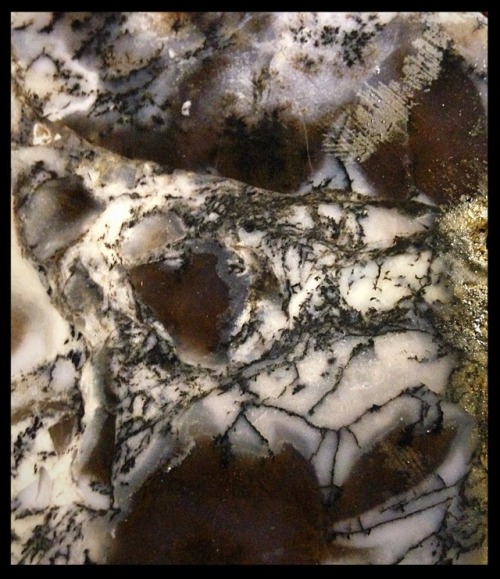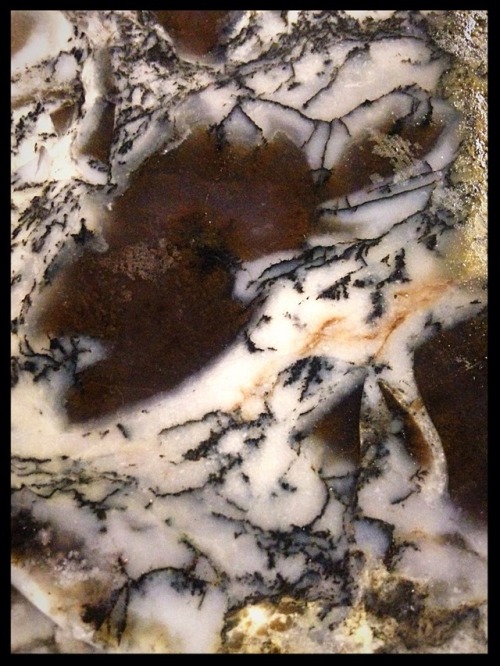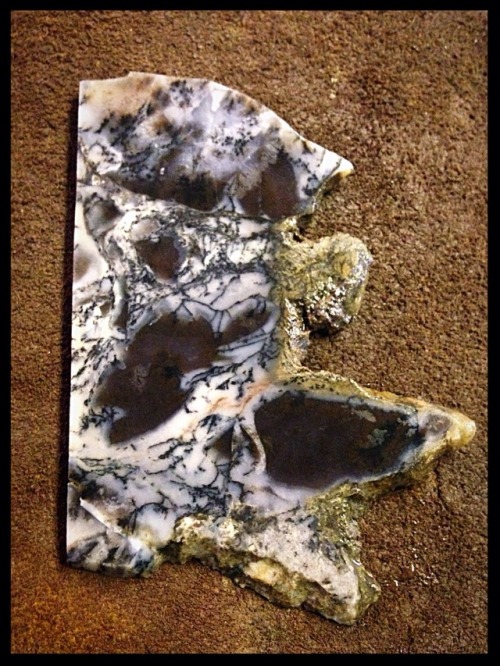#dendrites
Battery: In-situ Microscopy
Al 75, Cu 25 (wt%), hypoeutectic alloy
Processing: Sand cast
[…]
Sample preparation: Etched in sodium hydroxide solution
Technique: Reflected light microscopy
Length bar: 40 μm
Further information: The micrograph shows primary Al dendrite arms (white). The dendrite trunk has been intersected at an angle by the plane of polishing to give the observed morphology. Between the dendrites is the Al - CuAl2 eutectic. Initially dendrites would have formed from the liquid, the regions between the dendrite arms known as the mushy zone transforming to a eutectic solid (L to Al + CuAl2). These two phases form cooperatively as neighbouring lamellae with the lateral diffusion of material across the growing interface. The relative amounts of the two phases (Al and CuAl2 ) within the eutectic are determined by applying the Lever Rule at the eutectic temperature.
Contributor: Prof T W Clyne
Organisation: Department of Materials Science and Metallurgy, University of Cambridge
Post link
Scientists discover new field affecting metals solidification
A fundamental discovery that alters our current understanding of how metals solidify and form crystalline patterns may help lead to better control of casting and welding processes. It also explains how snowflakes and many mineral patterns form naturally.
Reexamining data from his 20-year-old NASA experiment involving the repeated freezing and melting of high-purity materials in microgravity, Martin Glicksman, research professor in materials science and the Allen Henry Chair at Florida Institute of Technology, working with Kumar Ankit at the School of Matter, Transport and Energy at Arizona State University, discovered the way nature guides formation of complex patterns in materials that crystallize.
Glicksman discovered an energy field affecting all crystallizing substances, which he labeled the bias field that he believes is nature’s way of guiding cellular and branching dendritic microstructures that form during solidification of most metals and alloys.
“In the last phases of melting, needle-like crystals suddenly changed to spheres, and so for the first time ever, as we watched stationary particles melting in microgravity and observed their rather remarkable shape change,” Glicksman said.
Post link





As a Rockhound, one must learn to trust your inner feelings when finding and identifying a piece of unusual material! Here is a classic example that we recently found on our last trip out, the first photo is what the rock looks like on the outside (it was actually dry and dirt covered when I found it), it looked like a big hunk of Basalt with little specks of agate strewn across the surface. Weighing in at around 10 pounds, this was a tough decision, put it in my pack and continue hiking around looking for better materials or pass it up because it really was not promising to look at. I trusted my gut and stuffed it in the pack, I carried this extra 10 pounds around for the rest of the day since I was nowhere near my truck to unload it.
After a great adventure in the Central Oregon high desert, we made it back with a bounty of new materials to work with including a big hunk of curious Basalt, low and behold, after the first cut on the saw, I was utterly astonished at what I had found, it turns out to be an incredible piece of colorful, dendritic moss agate that looks nothing like what we expected to see once it had been opened up!
So this is why you study hard, learn as much as you possibly can and have faith in your instincts when the natural world reaches out and gives you a great big hug. Mother Nature has a lot of hidden treasures just waiting to be discovered, get out there and see it for yourself!
Cheers, Tut
Snake River Dendritic Agate, rare old stock! https://www.etsy.com/listing/619304844/snake-river-dendritic-agate-rough-slab
Post link

Researchers at the University of Bonn have shed light on the function of the enzyme SLK for the development of nerve cells in the brain. If it is missing, the neurons’ branches are less abundant. In addition, it is then more difficult to inhibit the activity of the cells. This is consistent with the fact that there is less SLK in diseased brain tissue from epilepsy patients. Epileptic seizures are characterized by overexcitation of neuron clusters. The findings may help to improve treatment of the disease. The study is published in the prestigious Journal of Neuroscience.
SLK belongs to the large group of kinases. These enzymes are extremely important: They attach phosphate groups (which are small molecular residues with a phosphorus atom in the center) to proteins and thus alter their activity. Kinases are involved in the regulation of almost all life processes in animals.
The kinase SLK was already known to play an important role in embryonic development: One of its effects is on the growth of cells and their migration in the body; these processes are also essential for the maturation of neurons. “We therefore investigated what function SLK performs in nerve cells,” explains Prof. Dr. Albert Becker from the Institute of Neuropathology at the University of Bonn.
The researchers inhibited the production of the SLK protein in neurons of mice. “This changed the appearance of the neurons,” says Anne Quatraccioni, who is doing her doctorate at the Institute of Neuropathology in the research group of Prof. Dr. Susanne Schoch McGovern: “The dendrites, which are the extensions that receive signals from other neurons and conduct them to the cell body, branched less.”
SLK deficiency makes neurons more excitable
The dendrites resemble a kind of tree dotted with tiny contact points, the synapses. This is where extensions of other nerve cells dock and transmit electrical impulses to the tree. The observed “thinning” did not affect the thick main branches, but exclusively the smallest shoots. The synapses on these small branches are called excitatory: Signals received there have an arousing effect. This means that they increase the probability that the neuron will in turn generate an electrical signal, in other words, that it will “fire”.
When there are fewer side branches, the synapses could concentrate in a smaller area and thereby gain influence, making the neuron easier to excite (since the synapses are excitatory). “Surprisingly, however, we did not find an increased density of excitatory synapses,” Quatraccioni points out. “Nevertheless, the affected neurons were more excitable. But there had to be other reasons.”
The cause is not to be found in the delicate twigs, but in the thick main branches. Numerous synapses are also located there, but of a different type: They have an inhibitory effect. Any signal received by these synapses prevents the nerve cell from firing. “The mice initially formed a normal amount of these inhibitory synapses,” Quatraccioni explains. “However, after a few days of life, their density began to decrease. This loss kept progressing.”
SLK therefore appears to be important in maintaining normal levels of inhibitory synapses. Without the kinase, the affected neurons become increasingly difficult to inhibit over time. This fits in with the fact that the researchers were able to detect SLK deficiency in the nerve cells of brain tissue from epilepsy patients. During epileptic seizures, whole areas of the brain are overexcited, meaning that the neurons fire too easily.
Explanation for declining drug efficacy?
The findings could also explain why the effects of the drugs diminish over time in some sufferers. “Perhaps this effect is not due to resistance to the drugs, but to the progressive loss of the inhibitory synapses,” says Prof. Dr. Susanne Schoch McGovern. The findings therefore provide new insights into how the disease develops.
They could also have therapeutic relevance: “We often try to prevent neuronal overexcitation with drugs that stimulate inhibitory synapses,” explains Schoch McGovern. “This might be the wrong strategy in the case of an SLK deficiency: At some point, there are so few inhibitory synapses left that this no longer works. It is probably more promising in these patients to intervene on the excitatory side, that is, to inhibit the excitatory synapses.”
(Image caption: Nerve cells from mice - with normal (top) and reduced SLK expression (bottom). Without SLK, dendrites branch less; moreover, the number of inhibitory synapses (green) decreases. Credit: © Institute of Neuropathology/University of Bonn)
www.mlinspirations.com
Dendrite Opal is considered as a Stone of Plenitude that offers the fullness and abundance in one’s life. The energies of the dendrite Opal are quite passionate and vibrant, yet caring and gentle.
This little beauty has just been listed ❣️ snatch her before she’s gone ~ she measures 2inch long and will arrive complete with a sterling silver chain ❣️#sterlingsilver #silver #teardroppendant #gemstonelover #gemstonelovers #gemstonejewelry #dendrite #dendrites #opal #opaljewelry #pendant #pendantnecklace #pendantforsale #jewelrytrends #swag #gypsystyle #michellelouiseinspirations #blackfriday2018 #bfd2018 #love #shopifystore #vintagefashion #vintagejewelry #shoplocal #smallshop #smallbussiness
https://www.instagram.com/p/BqJhN1sAGPP/?utm_source=ig_tumblr_share&igshid=6ktyynbtz1ul
Post link
www.mlinspirations.com
Dendrite Opal is considered as a Stone of Plenitude that offers the fullness and abundance in one’s life. The energies of the dendrite Opal are quite passionate and vibrant, yet caring and gentle.
This little beauty has just been listed ❣️ snatch her before she’s gone ~ she measures 2inch long and will arrive complete with a sterling silver chain ❣️#sterlingsilver #silver #teardroppendant #gemstonelover #gemstonelovers #gemstonejewelry #dendrite #dendrites #opal #opaljewelry #pendant #pendantnecklace #pendantforsale #jewelrytrends #swag #gypsystyle #michellelouiseinspirations #blackfriday2018 #bfd2018 #love #shopifystore #vintagefashion #vintagejewelry #shoplocal #smallshop #smallbussines
https://www.instagram.com/p/BqJg6UnAe8H/?utm_source=ig_tumblr_share&igshid=1cn6qslxqfc87
Post link

![Al 75, Cu 25 (wt%), hypoeutectic alloy Processing: Sand cast[…]Sample preparation: Etched in Al 75, Cu 25 (wt%), hypoeutectic alloy Processing: Sand cast[…]Sample preparation: Etched in](https://64.media.tumblr.com/79ecb73957bcb39176b5d6c751534161/tumblr_ovkv9cYTp91u00si6o1_500.jpg)




